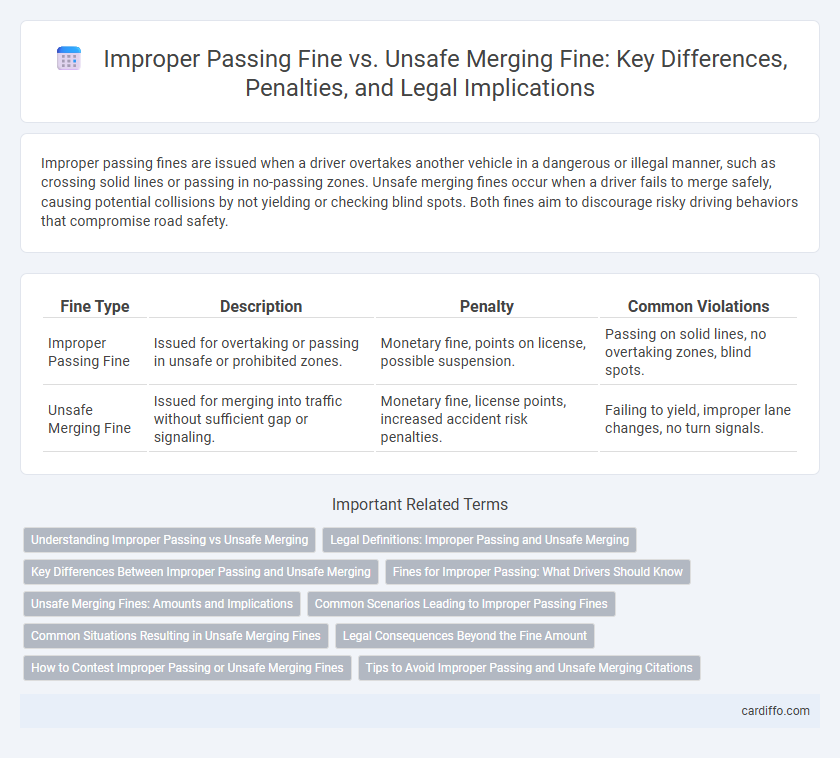Improper passing fines are issued when a driver overtakes another vehicle in a dangerous or illegal manner, such as crossing solid lines or passing in no-passing zones. Unsafe merging fines occur when a driver fails to merge safely, causing potential collisions by not yielding or checking blind spots. Both fines aim to discourage risky driving behaviors that compromise road safety.
Table of Comparison
| Fine Type | Description | Penalty | Common Violations |
|---|---|---|---|
| Improper Passing Fine | Issued for overtaking or passing in unsafe or prohibited zones. | Monetary fine, points on license, possible suspension. | Passing on solid lines, no overtaking zones, blind spots. |
| Unsafe Merging Fine | Issued for merging into traffic without sufficient gap or signaling. | Monetary fine, license points, increased accident risk penalties. | Failing to yield, improper lane changes, no turn signals. |
Understanding Improper Passing vs Unsafe Merging
Improper passing fines typically apply when a driver overtakes another vehicle in violation of traffic rules, such as crossing solid lines or exceeding speed limits. Unsafe merging fines are issued when a driver merges into traffic without sufficient space or signaling, creating hazardous conditions. Understanding the distinction between these violations helps drivers avoid penalties and maintain road safety by adhering to proper passing and merging protocols.
Legal Definitions: Improper Passing and Unsafe Merging
Improper passing is legally defined as overtaking another vehicle in violation of traffic laws, such as passing in no-passing zones or on the shoulder, which compromises road safety and can result in fines and penalties. Unsafe merging involves entering or changing lanes without sufficient clearance or signaling, creating a hazard that may lead to collisions and is subject to legal sanctions. Both offenses reflect violations of traffic regulations aimed at preventing accidents and ensuring orderly traffic flow.
Key Differences Between Improper Passing and Unsafe Merging
Improper Passing fines typically result from violating traffic laws by overtaking vehicles in restricted zones, while Unsafe Merging fines occur when a driver fails to merge safely, causing potential hazards. The key difference lies in the nature of the violation: improper passing deals with unauthorized overtaking maneuvers, whereas unsafe merging involves entering a lane without adequate space or signaling. Enforcement agencies prioritize evidence of risk to road safety, with improper passing often carrying higher penalties due to the increased danger posed by overtaking violations.
Fines for Improper Passing: What Drivers Should Know
Fines for improper passing vary by state but typically include penalties ranging from $100 to $500 and points added to the driver's license, increasing insurance premiums. Unsafe merging fines often carry similar financial penalties but also emphasize endangering other drivers by failing to yield or signaling properly. Understanding the legal consequences of improper passing helps drivers avoid costly fines and enhances road safety by encouraging adherence to traffic laws.
Unsafe Merging Fines: Amounts and Implications
Unsafe merging fines typically range from $150 to $300, depending on the jurisdiction and severity of the violation. These fines aim to deter reckless driving behaviors that compromise road safety by penalizing drivers who merge without sufficient space or signal, increasing the risk of collisions. Repeat offenders may face higher fines, points on their driving record, and potential license suspension, emphasizing the critical need for safe merging practices.
Common Scenarios Leading to Improper Passing Fines
Common scenarios leading to improper passing fines often include overtaking in no-passing zones, attempting to pass on curves or hills with limited visibility, and passing a vehicle while approaching intersections or pedestrian crossings. Drivers may also incur fines when passing in lanes designated for turning or failing to signal before changing lanes. These violations compromise road safety by increasing the risk of collisions and obstructing traffic flow.
Common Situations Resulting in Unsafe Merging Fines
Unsafe merging fines often arise from common situations such as failing to signal intentions when changing lanes, merging abruptly without checking blind spots, or forcing entry into congested traffic flow. Drivers who neglect to maintain a safe distance or merge at excessive speeds also increase the likelihood of receiving fines. Law enforcement monitors these behaviors closely to prevent accidents and ensure smooth traffic movement.
Legal Consequences Beyond the Fine Amount
Improper passing violations often lead to harsher legal consequences such as license suspension, increased insurance premiums, and points added to the driver's record, reflecting the high risk of collisions during illegal overtaking. Unsafe merging offenses, while also penalized with fines, frequently result in mandatory traffic school and stricter monitoring to prevent accidents caused by failure to yield or misjudging traffic flow. Both infractions can escalate to criminal charges if they cause accidents, emphasizing that legal consequences extend significantly beyond just the monetary fine amount.
How to Contest Improper Passing or Unsafe Merging Fines
To contest an improper passing or unsafe merging fine, gather clear evidence such as dashcam footage or witness statements that demonstrate safe driving behavior. Review the specific traffic laws cited in the ticket to identify any discrepancies or procedural errors made by law enforcement. Filing a formal contest through the local traffic court and presenting your evidence and legal arguments increases the chances of reducing or dismissing the fine.
Tips to Avoid Improper Passing and Unsafe Merging Citations
To avoid Improper Passing fines, drivers should always use designated passing zones, signal intentions early, and maintain safe following distances. Preventing Unsafe Merging citations involves checking blind spots, yielding appropriately, and smoothly adjusting speed to match traffic flow. Consistently practicing these behaviors reduces the risk of violations and enhances road safety.
Improper Passing Fine vs Unsafe Merging Fine Infographic

 cardiffo.com
cardiffo.com